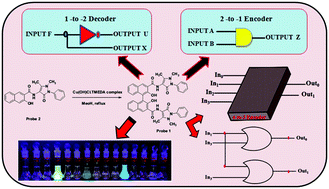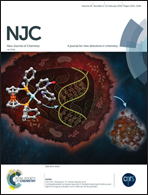BINOL-based differential chromo-fluorescent sensor and its application in miniaturized 1-2/4-2 bit encoders and decoders†
Abstract
A BINOL (1,1′-bi-2-naphthol)-based probe 1 with a diamide group has been synthesized and investigated for its photophysical behavior towards various cations and anions. Probe 1 has been used for the estimation of Al3+ and Cu2+ ions in the presence of other metal ions, signaling the binding event through the formation of new absorption bands at 415 and 430 nm. Differential emission bands are formed in the presence of Al3+ at 515 nm and Zn2+ at 485 nm, while quenching is observed in case of Cu2+ ion. Probe 1 shows selective estimation for CN− ion among all other anions by forming a new absorption band at 395 nm and new emission band at 495 nm, with the lowest detection limit of 2 μM. Based on these results, the anion/cation as well as cation/cation 2-to-1 encoder and 1-to-2 decoder have been formed. Moreover, a 4-to-2 encoder has also been established by using various cations as inputs.



 Please wait while we load your content...
Please wait while we load your content...